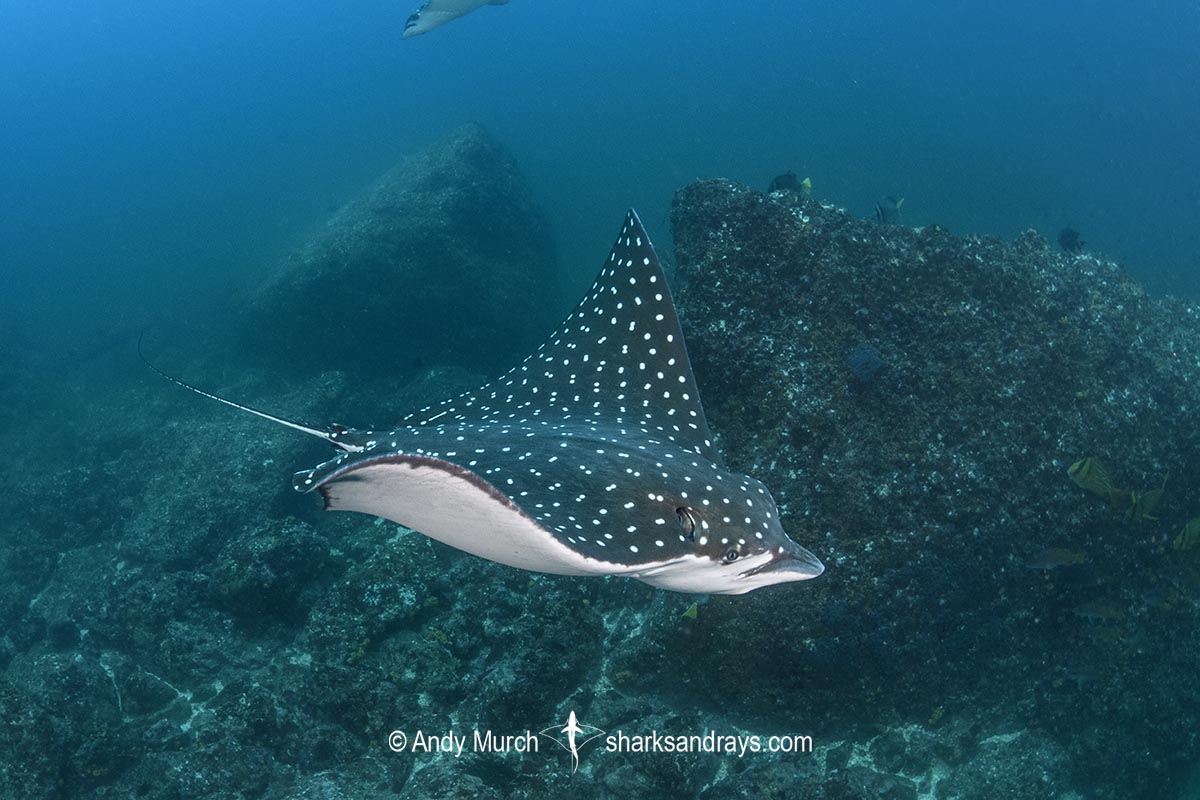Common name(s)
Pacific Eagle Ray, Spotted Eagle Ray.
Binomial
Aetobatus laticeps
Synonyms
Aetobatis laticeps
Identification
A large ray with a rhomboidal disc that is significantly wider than long. Large, protruding head with a moderately long, parabolic rostral lobe. Spiracles large. Mouth narrower than pre-oral (rostral lobe) length. Nasal curtain large, with a fringed posterior margin and deep central notch. Powerful pectoral fins have straight anterior margins, concave posterior margins, and falcate, pointed apexes. Pectoral fin origin level with eyes. Dorsal fin small, with a broadly rounded apex. Disc entirely smooth; lacking thorns. Tail filamentous and long when intact. One or more tail spines present.
Colour
Dorsum slate grey, blue-grey, or almost black, with numerous small white spots on disc and head. Spots present to disc margins. Tail unmarked. Ventrum white, without noticeably dark pectoral apices or mottling.
Size
Max. disc width at least 230cm but usually less than 130cm.

Conservation Status
VULNERABLE
The Pacific Eagle Ray (Aetobatus laticeps) is caught in artisanal gillnet and longline, purse seine, and industrial shrimp trawl fisheries throughout its range. Previously thought to have some refuge in the Galapagos Islands and other protected areas, new data indicates that eagle rays from all offshore islands in the eastern Pacific are actually the ocellated eagle ray (Aetobatus ocellatus). Consequently the IUCN’s designation of vulnerable may need to be raised.

Habitat
Tropical/subtropical seas. Sandy bays, coral reefs, and rocky outcrops. Sometimes in brackish estuaries. Often seen swimming close to the substrate, but also occurs in midwater and sometimes near the surface. Intertidal to at least 30m depth (personal observation) and probably much deeper.
Distribution
An eastern Pacific endemic, occurring along the west coast of the Americas from Mexico to Ecuador. Absent from offshore islands in the Eastern Pacific.
Reproduction
Matrotrophic viviparity. Litter size unknown.
Diet
Diet consists mainly of bivalves, but also consumes polychaetes, shrimps, and small fishes.
Behavior
May be found solitary or in groups. Excavates deep holes in the sand to capture benthic invertebrates.
Reaction to divers
Usually shy around scuba divers. May be more approachable when digging for food.
Diving logistics
Pacific eagle rays are quite easy to find along the Pacific coast of Costa Rica and Panama. I have encountered them at numerous sites including Isla Catalina, Montezuma, and at the Bat Islands in CR. As well as at Isla Iguana and Coiba in Panama.
What’s new
View our full list of updates
Similar species
Ocellated Eagle Ray. Occurs at offshore islands in the Eastern Pacific but absent from the continental coastline. Distinguished by ventral fin tips which are dark with white spots or mottling.



